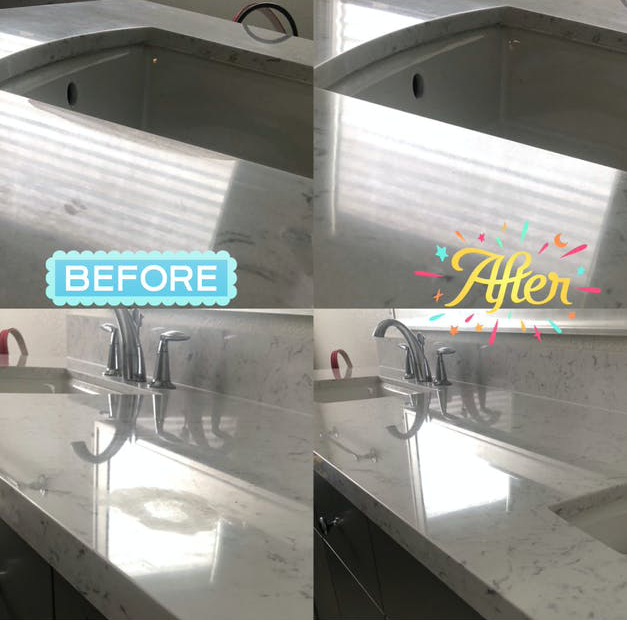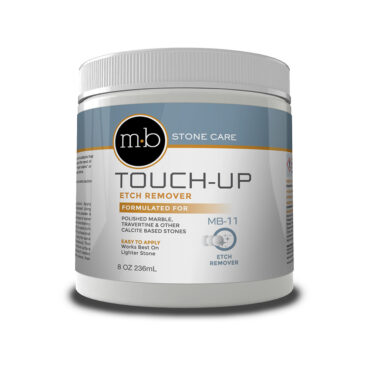MB-11® Touch Up
Expert Advice
Industry Leader
Made in the USA
Safe for Natural Stone
Trusted by Professionals
About the Product
Guide
Reviews
FAQs
Data Sheets

MB-11® Marble Etch Remover
Marble surfaces add a touch of elegance and luxury to any space. However, they are susceptible to etching and staining from everyday acidic substances. MB-11® Marble Etch Remover is the perfect solution to restore and maintain the pristine appearance of your marble surfaces.
MB-11® Touch Up is a remarkable blend of exclusive abrasives and catalysts that allows you to effortlessly achieve stunning marble polishing results, without relying on power tools. Say goodbye to cumbersome methods and say hello to a simpler way of restoring your marble’s natural beauty!
Specifically created for spot polishing, MB-11® Touch Up is your go-to solution for effortlessly removing those bothersome “water stains” or annoying “rings” from any polished marble, travertine, or calcite-based stone.
Its magic works wonders, especially on lighter stones, leaving them gleaming and spotless. Experience the joy of marble polishing made easy with MB-11® Touch Up.
Say hello to breathtaking marble surfaces and bid farewell to the complex and time-consuming methods of the past. Join countless others who trust MB-11® Touch Up for its simplicity and incredible results.
Note:
- NOT for honed finishes!
- NOT for dark stones!
All powders are packed by weight and not by volume.
Type and Formulation
MB-11® Marble Etch Remover is a premium etch remover and marble polishing compound. The formulation includes a blend of specialized polishing compounds designed to restore the natural polish of marble through a process of abrasion and friction, closely replicating the original factory finish.
Why Use MB-11® Touch Up Marble Etch Remover
This product is specifically designed to address issues such as etching, water stains, and light scratches on a variety of polished stone surfaces, including:
- Marble
- Travertine
- Alabaster
- Onyx
- Polished Limestone
Tips for Best Results
- Always test a small, inconspicuous area first to ensure compatibility.
- For larger or deeper etches, multiple applications may be necessary.
- Reseal the marble surface after treatment to maintain protection.
Water Stains and Light Scratches
MB-11® effectively removes water stains and light scratches, restoring the smooth, polished appearance of your stone surfaces.
Note: Homeowners often mistake etching for water marks or rings. MB-11® is specifically formulated to address these issues, providing a clear, polished finish.
Time Efficient
MB-11® works quickly, making it a convenient solution for busy homeowners looking to maintain their marble surfaces without extensive effort.
Recommendations for Use
For Minor Etching
MB-11® is ideal for minor etching that is not rough to the touch and does not cover an extensive area. It allows for easy, at-home restoration.
For Severe Etching
If etching is severe, rough to the touch, or covers a large area, professional restoration services may be required to achieve the best results.
Preventative Care
Regular sealing of marble surfaces every 6 months to a year is crucial to prevent future staining, but does NOT prevent etching. Unfortunately, etching is only prevented when topical applications are applied. Call us for recommendations for that and finding a professional near you who can help.
Safety Information
Child Safety
Keep MB-11® out of reach of children to prevent accidental ingestion or contact.
Additional Information
MB-11® is not recommended for use on granite or honed marble surfaces. It is specifically formulated for polished stones.
Professional Help
For severe etching or if the surface is rough, seeking professional help is advised to ensure the best possible restoration results.
Maintenance Tips
Post-Application
After using MB-11, it is important to reseal the marble surface as the original sealer may be compromised during the etch removal process. Regular maintenance will keep your surfaces looking their best.
Preventative Measures
Regular cleaning and proper care will prolong the beauty and longevity of your marble surfaces. Using place mats, trays, or other preventative options will help keep etching to a minimum.
Note:
- NOT for honed finishes!
- NOT for dark stones!
- All powders are packed by weight and not by volume.
Preparation:
- Be certain to test the product first on a spare tile or inconspicuous area for extra caution before use.
- Use rubber gloves at all times when handling the product.
- Clean the surface with something like our Easy Oxy Daily Cleaner.
Directions:
- Use rubber gloves. Grab a clean white cloth or microfiber and fold it twice to make 4 layers. Wrap it tightly around your fingers/knuckles. Hold the loose portion of the towel in your hand so that it stays out of the way while you work. Dampen the wrapped fingers by spritzing them with water. Remove any excess water as you want your cloth damp, not wet.
- Tap your damp cloth into the powder in the jar to get a THIN layer on your wrapped fingers/knuckles. There should be a consistent layer of powder, but no excess flaking off.
- Rub the affected area vigorously with the wrapped fingers in a back-and-forth motion. This should be done quickly and with a lot of pressure. After about 10 back-and-forth motions, finish up with a few circular motions.
- If you have any residue left do NOT wipe it away with the cloth until you have neutralized it with a pH-neutral cleaner like our MB-5. Use the loose part of the towel to wipe away the paste in a single motion. Spray the spot with a pH-neutral cleaner and buff clean with a SECOND microfiber cloth. Do NOT use the same cloth used to apply the product.
- Inspect the repaired area and repeat the process with the same cloth as necessary. Adding more water if needed.
Sometimes the area may need to be resealed. To determine if you need to seal your stone, try doing a water test on the stone’s surface.
Frequently Asked Questions
What Surfaces Can You Use MB-11® Marble Polishing Powder?
How Do You Use the MB-11® Marble Polishing Powder?
What's the Difference Between Honed and Polished Marble?
Why Does Marble Leave Etch Marks?
What Are Some Tips for Using MB-11® Marble Polishing Powder?
